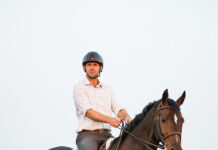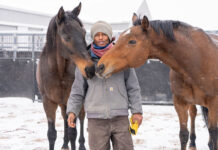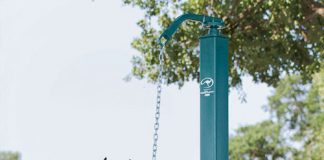
Q: My 4-year-old horse is usually very laid-back about everything. However, when we start loping, he starts bucking. I have checked my tack and nothing seems to pinch him, so maybe he is just young and excited. How can I fix this habit?
— Celine Rickels, Iowa
Kicking up, or “crow hopping,” is a simple demonstration of a horse’s lack of respect. What type of horse usually kicks up? A lazy one that doesn’t want to go forward. When you ask a horse like this to go from a jog to a lope and he kicks up with his back legs, it’s his way of telling you to get lost.
On the other hand, most horses that are really bucking are not showing a lack of respect. They are most likely reacting to fear: the fear of a rider being on their back, the girth, the back cinch, the rider’s legs, the spurs, or something that jumped out of the bushes. Something caused them to use the reactive side of their brain. That’s how most horses learn to buck. Sometimes, once a horse has dumped a rider three or four times and has gotten used to bucking, he starts bucking out of habit, not so much out of fear.
Whether your horse is kicking up to demonstrate his lack of respect or is truly bucking out of fear or habit, there are several ways to fix the problem. If he’s kicking up because he doesn’t want to go forward (which sounds accurate), get his feet moving better on the ground. Preferably, put him in a round pen (or on the longeline) and then point up in the air with your hand to signal him to move forward, then cluck and spank with a whip until he lopes around the round pen. First spank the ground, and if necessary, spank your horse. Get him so focused on you that as soon as you ask him to move by pointing with your hand, he immediately responds. If you get rid of his laziness and lack of respect on the ground first, he’ll be a lot more willing to go forward when you get on him. In fact, if you diligently do your groundwork, more than likely, kicking up under saddle will no longer even be an issue.
|
When you do get on your horse and ask him to lope, first squeeze with both legs to ask him to go forward. Wait for a count of two, and if he doesn’t go, cluck. Wait for another count of two, and if he doesn’t go forward, spank him from side to side with the end of your reins or a whip. If you spank with rhythm and he kicks up with both back legs, spank him again. You may have to spank him several times before he realizes that every time his hind legs leave the ground you will make him feel uncomfortable, but when he leaves his feet on the ground, you will leave him alone.
If your horse is truly bucking, the last thing you want to do is spank him because he’ll only buck harder. If he is bucking, immediately do a one-rein stop: bend his head and neck around to one side and try to get him to disengage his hindquarters. This takes away his ability to buck because his hind legs are moving laterally. As soon as he’s stopped, get off him and go right to work moving his feet on the ground. Don’t get off and put him away. If you do, you’ll teach him that bucking is what earned him a rest. Hustle his feet so he understands that bucking was a big mistake.
You do have to be a confident rider to go through this process. If you’re not, make sure you do your groundwork thoroughly and correctly so that your horse will go forward under saddle as soon as you squeeze and cluck. Or, have a more experienced rider get on for a few days to get your horse’s feet moving at the lope.
Clinician Clinton Anderson owns and operates Downunder Horsemanship in Stephenville, Texas, where his method of horsemanship has helped to transform the relationships between thousands of horses and riders. He also hosts two training programs that air weekly on Fox Sports Net and RFD-TV. www.downunderhorsemanship.com
This article originally appeared in the June 2012 issue of Horse Illustrated. Click here to subscribe!






I will certainly try these tips. I know that bucking is very common, and I hope everyone reads this article.
great info!
I still don’t understand why people think three one rein stop (aka, pulling a horses head around) works under every circumstance. I have seen and ridden many horses that have bucked and pulling their head around doesn’t make then always stop. If your house is athletic enough, he can continue bucking in a circle, just like when a bull spins. The proper way to get your house to stop bucking is to pull his head up. When his head is up he has a harder time kicking out and keeping the bucking rhythm. Look at the Bronx riders in rodeo. After the buzzer what do they do? They pull the horses head up and the horse starts moving forward at the run. They quit bucking.
The “one rein stop” will get an inexperienced rider hurt. Period.
This is in response to Chris. The use of the one rein stop assumes it has been properly taught. If your horse does not understand the cue and what it means then I would agree it would be ineffective in stopping unwanted behavior. However it has been my experience that in teaching a good one rein stop with a hind quarter disengage to your horse and reinforcing it it does wort to stop behaviors like bucking, trying to run off, etc. If the foundation training in not there then no it’s not a good solution.
He’s talking about a crow hopping horse, not a full bucking one. If the horse is in a full blown buck, his head is down and you would just draw his head into his chest. If you do manage to get his head up, he might come back on top of you and if not that, you might get hit in the face with the horses head.Tie a course string from the saddle horn to just under his neck just tight enough for him to feel it. He will not want to lower his head and he can’t buck or crow hop without lowering his head. This is temporary.It will give him a chance to get used to working with the lope.
I have a 4 yr old mare that will go along very nicely for 20 or 30 minutes and then all of a sudden rear to full height, and start broncing…all four feet off the ground, head between the front legs, etc. I have done 1 year of ground work following Tricky Warrior videos since mine is also off the track. What I eventually found out is she has Kissing Spine, her vertebrae touch and cause significant pain. What I also found out, one rein stops tweak the spine very badly when she is already in pain. We have gone back to more round pen work with the sole purpose of physical therapy to strengthen her stomach muscles. Please also have a vet look at your horse if you experience bucking and make sure they horse doesn’t have pain. I am about to start riding again in the next few weeks as soon as I can round pen with no more “episodes” for at least 2 weeks, then her muscles should be ready for me to start riding again. Wish me luck.
Good advice.
perhaps if your horse ws not held in the over bent behind the verticle head position, in dressage we get reamed for this from spectarors bt for some reason it is ok to see a western horse BTV, why because they are on a loose rein (with a great big bit and are punished for thinking of coming up for air.) Horses buck at the canter because of pain, riders sitting incorrectly or riders holding and closing off the inside rein and shoulder. As another lady here said, her horse had kissing spine, a more common occurrence than most people know. Most people also have no idea that the canter cue comes from the seat not the outside spur, and many mares object to the pain inflicted by that spur so far back into the ticklish flank area.
Horses never react from laziness, stupidity or stubborn meanness, they react from fear pain and confusion.